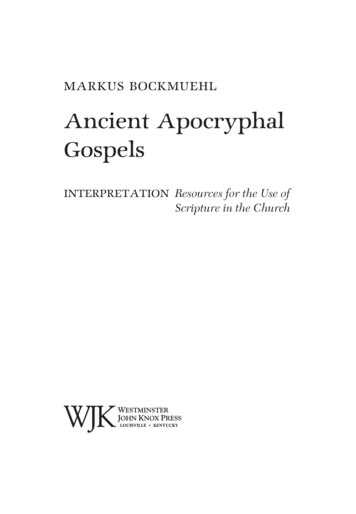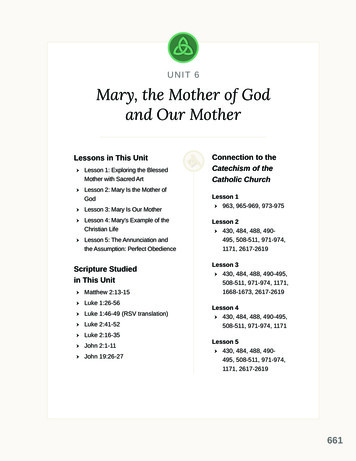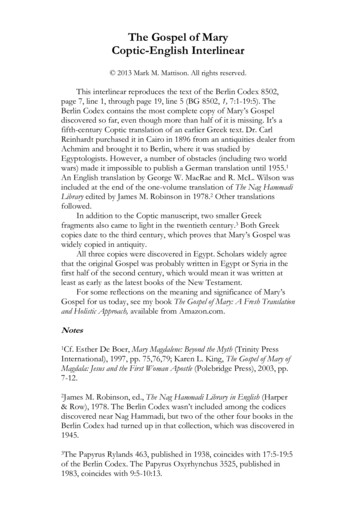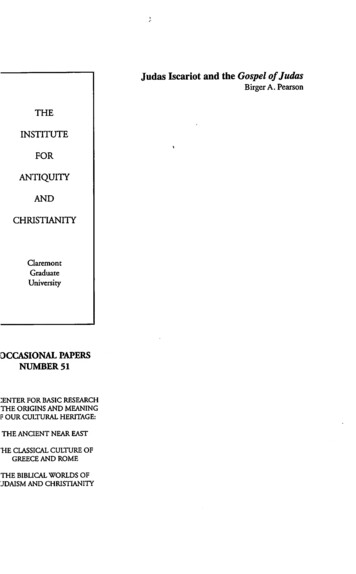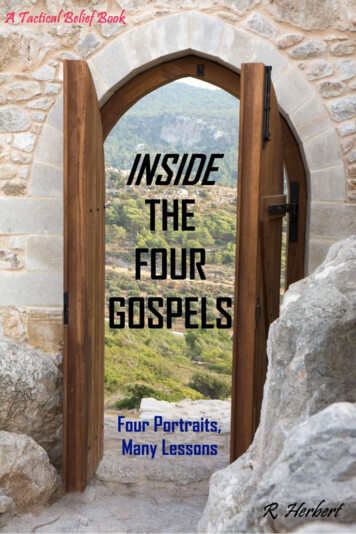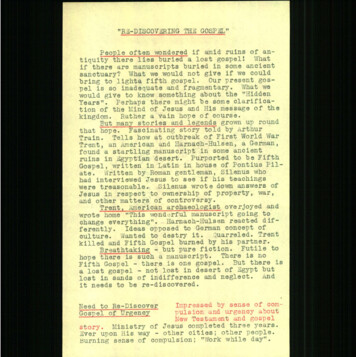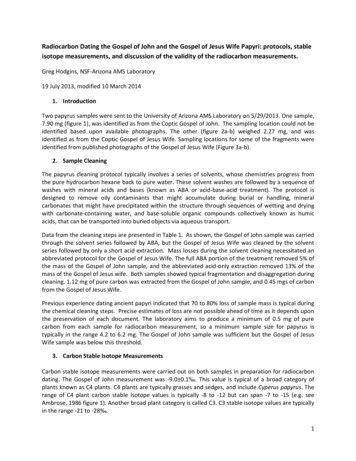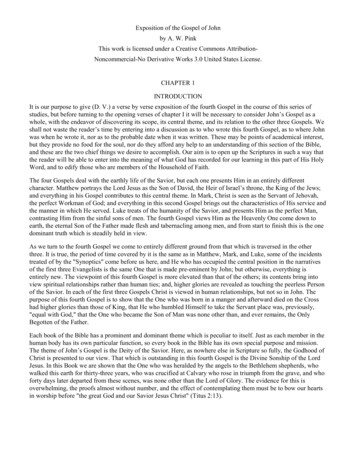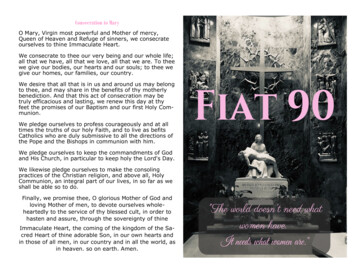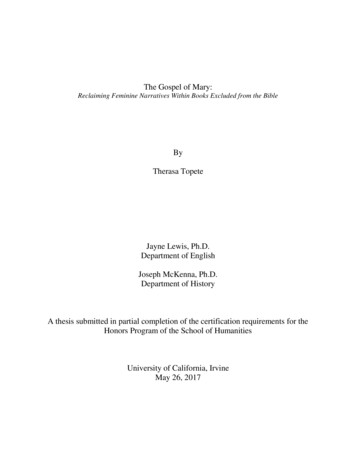
Transcription
The Gospel of Mary:Reclaiming Feminine Narratives Within Books Excluded from the BibleByTherasa TopeteJayne Lewis, Ph.D.Department of EnglishJoseph McKenna, Ph.D.Department of HistoryA thesis submitted in partial completion of the certification requirements for theHonors Program of the School of HumanitiesUniversity of California, IrvineMay 26, 2017
iiAcknowledgmentsI would like to thank the individuals and groups that have supported me through the year-long process ofproducing this thesis.I would like to thank the director of the School of Humanities Honors Program Professor Jayne Lewis. Ihave greatly appreciated your support and enthusiasm for my project. I am so grateful that you never gaveup on me and continued to draw out my passion for this labor of love, especially when I could not see away past the wall at times. Thank you.Thank you to my faculty advisor Joseph Mckenna who stepped in without a second thought to help methrough the end of this process. I appreciate that you are always willing to greet me with a smile andengage in some of the most interesting conversations I have had in my three years at UCI. You are thebest.Thank you to my peers in the humanities Honors program. Your encouragement and positive attitudeshave been a source of inspiration, and I have appreciated the opportunity to engage in amazingintellectual discussions twice a week for the last two years. You are all amazing.Lastly, I would like to say a big thank you to my family. Without your continued support and enthusiasmI would not have been able to return to school after a twenty-year absence. To my daughter Ahni, you aremy hero. You face the world with humor and strength, and you believe in me when I don’t believe inmyself and keep me going. It is all for you.
iiiAbstractReligious history is often preserved by the winners of ideological debates. The twenty-sevenbooks composing the New Testament canon were selected by prevailing players in the battle forideological supremacy within the early Christian movement and the emerging Catholic Church.The struggle culminated with an accepted definition of orthodoxy and a tradition of apostolicsuccession for legitimizing religious texts. The Gospel of Mary is an early Christian text deemedunorthodox by the men who shaped the nascent Catholic church, was excluded from the canon,and was subsequently erased from the history of Christianity along with most narratives thatdemonstrated women’s contributions to the early Christian movement. My thesis explores theintricacies of early canon formation within the context of the controversy surrounding women’sparticipation in authoritative roles within early Christianity and how the Gospel of Mary waslabeled as an unorthodox text due to its pro-feminine narrative. I maintain that the motive forexcluding the Gospel of Mary was not the text’s lack of conformity to the requirements ofapostolic succession or orthodoxy, but was grounded within the struggle to suppress the agencyand participation of women from the patriarchal hierarchy that defined the developing structureof the Catholic Church. I claim the exclusion of the gynocentric narrative of the Gospel of Maryfacilitated the androcentric interpretation of religious doctrine and history that has predominatedChristian scholarship for almost two millennia.
ivTABLE OF CONTENTSPART ONE: ALTERNATIVE TEXTS/ALTERNATIVE CHRISTIANITIES1EXCLUDED FOREVER?2THE VICTORS WRITE HISTORY5THE CREATION OF CANON, THE CREATION OF HISTORY8FOUND TEXTS, FOUND CHRISTIANITIES10PART TWO: THE GOSPEL OF MARY: RECLAIMING PRO-FEMININE CHRISTIANITY16“ THE SAVIOR MADE HER WORTHY ”17LISTENING TO THE SILENCE, MARY SPEAKS17“MARY STOOD UP”18MARY, THE PURE SOUL19“DID HE, THEN, SPEAK WITH A WOMAN ?”21MARY MANEUVERS THROUGH MISOGYNY24“ THE SAVIOR MADE HER WORTHY ”25JESUS SAYS NO NEW LAWS25TEXTS IN CONVERSATION28MARY IN “HERETICAL” CHRISTIAN WRITINGS28WOMEN IN ORTHODOX CHRISTIAN WRITING31THECLA SPEAKS33PART THREE: RECLAIMING MARY, RECLAIMING WOMEN35FINDING MARY36LEGITIMIZING MARY37THE PATRIARCHY STRICKES BACK39THE CRUCIFIXION OF MARY MAGDALENE42THE END OF MARY, THE SWAN SONG OF FEMININE NARRATIVES42TO END AT THE BEGINNING45BIBLIOGRAPHY48
Part OneAlternative Texts/Alternative Christianities
2Excluded Forever?In an interview conducted aboard his private plane on October 31, 2016, Pope Franciswas questioned by reporters regarding the Roman Catholic Church’s stance on allowing womento hold positions of church authority. As the jet soared through the atmosphere at 40,000 feet,progressing towards its destination of Vatican City, Pope Francis re-affirmed the Church’slongstanding position on women’s roles within the institution as he unequivocally stated that,“on the ordination of women in the Catholic Church the last word is clear, the Roman CatholicChurch’s teaching that women cannot be ordained as priests will likely last forever.”1At the time of the interview Pope Francis was returning to the Vatican from anecumenical mass in Lund, Sweden, presided over by Archbishop Antje Jackelén. ArchbishopJackelén is the Lutheran Archbishop of Uppsala in Sweden, and Primate (prima inter pares—which translates from Latin as first among equals) of the Church of Sweden. The Archbishop ofUppsala has been the primate of the Church of Sweden in an unbroken succession since 1164CE, initially as part of the Catholic church and then under the Lutheran church from 1531CEafter the Protestant Reformation. Archbishop Antje Jackelén is a woman. The mass was aceremonial celebration recognizing the upcoming 500th anniversary of the ProtestantReformation. For the Pope to reaffirm the Catholic church’s exclusion of women from positionsof church authority, after just having participated in a religious event with a female ProtestantArchbishop, highlights the Catholic church as an institution firmly committed to maintainingantiquated ideologies within a world increasingly influenced and defined by modernity. During1Laurie Goodstein, "Pope Francis Says Ban on Female Priests Is Likely to Endure," The New York Times, November 1, 2016) 1.
3the interview, Pope Francis also made a point to praise the Swedish government as a championof human rights in their efforts to welcome and integrate refugees and immigrants. Ironically,Pope Francis noted that, “It’s not human to close doors! It’s not human to close the heart.”2In stating the rationale behind his reaffirmation of the church’s position, a seeminglyoutdated ideology frozen in space and time for millennia, Pope Francis cited the OrdinatioSacerdotalis, an apostolic letter written to the Bishops of the Catholic Church by Pope John PaulII in 1994, maintaining the ordination of priests was reserved only for men.3 The OrdinatioSacerdotalis was an official declaration of the church’s long standing position excluding womenfrom the priesthood and positions of church authority, a stance that can be traced back to the verybeginnings of the Christian movement. Pope Francis cited the two fundamental reasons outlinedin the Ordinatio Sacerdotalis: 1) That it has been the constant practice of the church from thebeginning of Christianity, and 2) Based on scriptural evidence, Jesus only chose male disciples.Did he?The notion that an exclusively male priesthood is in accordance with Jesus’ teachings hasbeen preserved by the universal tradition of the Catholic Church for two thousand years. Yet, adebate now exists regarding the role of women in early Christianity, one that is being shaped byrecently discovered texts concerning the formation of the early Christian church, and callsattention to narratives that influenced church doctrine and ideology. The understanding thatwomen should be excluded from church leadership relies on the interpretations of texts widelyaccepted as being the definitive authority in representing the history and teachings of the founder2Ibid., 2.Apostolic Letter Ordinatio Sacerdotalis of John Paul II to the Bishops of the Catholic Church on Reserving Priestly Ordinationto Men Alone, 1.3
4of the Christian religion, his followers, and the events that shaped the emergence of the Christianchurch as an ideological structure and institution. Yet, the discoveries of these ancientmanuscripts has provided alternative narratives that counter the widely-accepted interpretationsof the history of the early church and its doctrine. The Gospel of Mary is one of these newlyunearthed ancient Christian texts that challenges the established role of women in the church,and offers an alternative narrative of early Christianity.The following thesis explores the intricacies of early canon formation within the contextof the controversy surrounding women’s participation in authoritative roles within earlyChristianity. I will demonstrate how the Gospel of Mary was labeled as an unorthodox text dueto its pro-feminine narrative and how analysis of excluded texts allows scholars to understand theprocess of canon formation in a way that was not possible by simply by focusing on the texts thatwere not excluded. I will challenge the exclusion of the Gospel of Mary for the texts lack ofconformity to the requirements for apostolic succession or orthodoxy, and confront thepredominant focus on the gospel’s exclusion as a heretical Gnostic text. I maintain that themotive for excluding the Gospel of Mary did not stem from the text’s lack of conformity to therequirements of orthodoxy, or the apparent gnostic nature of its content, but was grounded withinthe struggle to suppress the agency and participation of women from the patriarchal hierarchythat defined the developing structure of the Catholic Church. I claim the exclusion of thegynocentric narrative of the Gospel of Mary facilitated the androcentric interpretation ofreligious doctrine and history that has dominated Christian scholarship for almost two millennia.Further, I address how the androcentric narrative of early church formation has impacted howscholars understand and interpret the history of Christianity, and I argue that this male-centeredlens has not only erased feminine contributions from history, but disenfranchised women from
5their own history and intrinsically excluded them from their own essential experience of thesacred.The Victors Write HistoryThe early Christian movement did not possess any of the features traditionally associatedwith Christianity today, such as an official New Testament canon, the Nicene Creed, theestablishment of the Trinity, or any formal hierarchical structure. Early Christianity consisted ofseveral emerging groups or sects, each with its own diverse and rich developing ideology, thatdid or did not necessarily align themselves with the beliefs and ideologies of any of the otheremerging groups. As Christianity developed over the first few centuries of the common era,many of these sects found themselves in direct competition with one another over possession ofthe “true” ideology. Christianity has been steeped in controversy and debate since the death ofits founder initiated a new religious movement and, as scholar Karen L. King observes, “Allearly Christian literature bears the traces of these controversies.”4 It is important to note thatChristianity was not a ready-made institution of agreed upon beliefs and texts, but a slowlyforming structure that took shape over the first six centuries of the common era. This formationwas marked by struggle, and its history was preserved and recorded by the winners of ideologicaldebates.Three significant ideas had emerged by the second century: 1) Orthodoxy versus Heresy,2) Gnosticism was synonymous with heresy, and 3) Women in leadership equated heresy. Theconcept of orthodoxy, or “right belief,” was developing as a measure for competing ideologieswithin early Christian communities. The texts that countered this measure, or “Canon,” were4Karen L. King, The Gospel of Mary of Magdala: Jesus and the First Woman Apostle (SantaRosa, CA: Polebridge Press, 2003) 6.
6deemed heretical, meaning to “choose against” right belief. Recent scholarship has revealed thatunorthodox beliefs were by no means in the minority, and that theological concepts that becameassociated with right belief were inextricably connected to theologians and communities thatwere part of the forming hierarchal, and stratified, power structure of the nascent church. Theorthodox movement was determined to form a universal, or “Catholic,” church with uniformtheology and practices. These unified churches would become the definition of orthodoxy, andall other opposing views or practices that countered this unified front were deemed heretical.Therefore, the separation between heretical and orthodox communities is largely an orthodoxconstruct.Competing ideas that challenged the definition of orthodoxy were increasingly called“Gnostic” in nature. It is important to note that the people within these groups did not have ahomogeneous set of beliefs and did not refer to themselves as Gnostics or heretics, but asChristians. The term Gnostic, which translates as “knowing or knowledge”, was coined by earlyorthodox theologians to disparage alternative Christianities, thus the term Gnostic would becomea synonym for heretical. Although Gnostic theology was based on the concept of knowledge ofgod through self-knowledge, and a cosmology that modern observers may associate with Easternreligions, it was “unmistakably related to a Jewish heritage.”5 Gnostic Christianity adopted muchof the same ideology, terminology, and narratives as the orthodox movement, yet interpreted thisknowledge within its own theological framework and rejected the need for hierarchical structure.The Gnostic Christians were heavily persecuted by the early orthodox Christian church.A large collection of Gnostic texts, known collectively as the Nag Hammadi Library, was5Elaine Pagels, H. The Gnostic Gospels (New York: Random House, 1979) xix.
7discovered in a series of archaeological excavations in Oxyrhynchus, Egypt in the late eighteenthcentury and in upper Egypt in 1945. The Nag Hammadi collection includes thirteen codices,containing over fifty varied texts, including “Gnostic Gospels” that either added to, mirrored,challenged, or refuted many traditional Catholic canonical texts. Some of these important gnostictexts include: The Gospel of Thomas, The Sophia of Jesus Christ, The Gospel of Judas, and TheGospel of Mary.A commonality among many gnostic sects was that many allowed women in positions ofchurch authority. Women would teach, preach, prophesize, and perform rituals such as theEucharist. It is understandable that these communities would adopt an egalitarian methodologywithin their churches and congregations as many gnostic cosmologies were based on a godheadthat possessed both masculine and feminine attributes, and argued that the physical realm wastransitory and illusory. Gnosticism promoted the idea of the body as intangible and immaterial,therefore it is not surprising that gender divisions and gender roles were also considered illusoryin many gnostic communities. Women could participate equally in many gnostic churches, andthese women were sources of conflict between orthodox and heretical communities. Thus,women in authoritative roles became a target and also became synonymous with heresy.Texts and writings were extremely important in early Christianity. Christian communitiesformed around a text, or group of texts, and their varying interpretations of these texts reflectedtheir beliefs systems. Scholars agree that most Christian gospels and writings, orthodox as wellas heretical, were written anonymously or pseudonymously and named for figures closelyassociated with Jesus or his disciples to give them legitimacy.6 Between the second and seventh6King, The Gospel of Mary of Magdala, 184; Ehrman, Bart D., Lost Christianities: The Battle for Scripture and the Faiths WeNever Knew (New York: Oxford University Press, 2003) 11.
8centuries heretical texts were actively suppressed and destroyed—whether by the Orthodox orRoman authority—and all but erased from the historical record for more than fourteen centuries.The only evidence of their existence was through the polemic writings of orthodox theologiansand historians, whose disparaging descriptions of the texts supported the orthodox masternarrative being recorded for posterity. This master narrative was androcentric, that is malecentered, as it characterized the formation of the early Christian church as a process created, andrightly dominated, by men. Pro-feminine, or gynocentric, narratives were considered hereticaland excluded from the orthodox history of the church.The Creation of Canon, the Creation of HistoryThe compilation of the Christian canon was a process that transpired slowly, over thecourse of several hundred years from the mid-first to late-fourth century. The exact date of thecanon’s official formalization is unknown, possibly occurring as early as the late second centuryor perhaps as late as the fourth. In the second century, Bishop Irenaeus of Gaul, a prominentChristian theologian and early church father, extensively quoted and cited at least twenty-onebooks that would later become part of the formalized canon. In 367, Bishop Athanasius ofAlexandria, also a Christian theologian and prominent church father, composed a letter whichcontained the first complete list of all twenty-seven texts that would eventually become theofficial Christian New Testament canon. Although the exact date the canon was formalizedcannot be determined, it is clear by the start of the second century that most of the texts thatwould eventually constitute the official Christian Canon were already in circulation among theprominent Christian thinkers and Christian communities of the era.
9The New Testament canon includes the texts selected and approved by the developingChurch hierarchy and by the fourth century the burgeoning Christian church was reaching apinnacle in forming itself into a power structure. The influence of Constantine the Great and theFirst Ecumenical Council of Nicaea would initiate the process of settling remaining theologicalconflicts regarding such matters as the nature of Christ and the Trinity, and solidify an orthodoxdoctrine and ideology which would manifest into the Nicene Creed. The Roman Empire playedan integral part in the formation of the church as the actions of Constantine concretized a linkbetween the church and the empire. In 313 CE, Constantine issued the Edict of Milan legalizingChristianity, and he handed over the power of the church to the winners when he officially“recognized a group of male bishops as the established leadership of the church, and in doing sosanctioned a power structure that would govern Christianity for centuries to come.”7Yet, this power structure had already been dominating the Christian church and exertingits influence over Christian communities for over two-hundred years. When Constantine issuedhis edict of tolerance the losers in the ideological battle, namely any theology considered gnosticin nature or supporting women in church leadership, had already been marginalized by theorthodox community. Constantine merely threw his support behind a hierarchal structure thatwas already in place, and his insistence on calling ecumenical councils to settle disagreementsamong the winners brought the movement full circle, with the losers firmly on the outside. Thelast standing communities that formed around or circulated texts that were not on BishopAthanasius’ orthodox list, and who had not already succumbed to “having been displaced,7King, The Gospel of Mary of Magdala, 188.
10suppressed, reformed, or destroyed” by the orthodox movement, faced obliteration as the“Christian Bishops, previously victimized by police, now commanded them.” 8Early Christianity was marked by struggle. A conflict of ideas, and a battle for control of afledgling religious movement whose adherents had a wide range of beliefs. A variety of textsrecounting the events of Jesus’ life, his teaching, and the history of the Christian movement werein circulation and competing factions formed around one or many of these texts, each claimingtheir texts espoused the legitimate doctrine of the new movement. The legitimacy of these textswas connected to the author, and gospels that claimed to be directly connected to an apostle ofChrist became the determining factor for its validity. Every sect claimed their text was written bya legitimate apostle, or a disciple of an apostle, and it became necessary to establish criteria forapostleship by which the text could be judged to determine the authenticity of its contents. Tosupport a claim to apostleship a person would have to have been a witness to the resurrection andhave received a commission directly from Christ to spread his teachings. Resurrection witness andapostolic commission became the standard by which authorship was legitimized. The orthodoxchurch would assume the right to construct the master history of Christianity by claiming thelegitimacy of the texts that supported their theology and characterizations of the movement.Found Texts, Found ChristianitiesThe first known fragment of the Gospel of Mary is the Codex Berolinensus 8502,referred to as “The Berlin Codex.” It was purchased by scholar Dr. Carl Reinhardt at a Cairomarket in 1896. The codex, a precursor to the book form, was purported to have been unearthedin the city of Akhmim in Upper Egypt, but the exact location is unknown. The Gospel is a small8Ehrman, Lost Christianities, 250; Elaine Pagels, H. The Gnostic Gospels (New York: Random House, 1979) xviii.
11papyrus codex, written in Coptic, dating from the fifth century. The Berlin Codex contains themost complete copy of the Gospel of Mary found to date and consists of eighteen and a quarterpages with the first six pages, and pages eleven through fourteen, missing from the text. TheBerlin Codex also contains fifth century fragments of the Apocryphon of John, the Sophia ofJesus Christ, and the Acts of Peter.Two additional fragments of the Gospel of Mary were discovered in the early twentiethcentury in Oxyrhynchus, Northern Lower Egypt. Papyrus Rylands 463 was acquired by theRylands Library in Manchester England in 1917. It is a small fragment of the Gospel of Mary,written in Greek on both sides of papyrus leaf, and only contains chapters 9:29 thru 10:4 and10:6-14. Papyrus Rylands 3525 is a second fragment of the Gospel of Mary found atOxyrhynchus, Egypt, and is written in Greek on a single side of papyrus scroll, not in codexform. Papyrus Rylands 3525 only contains chapters 4:11 thru 7:3. Both the Papyrus Rylands 463and the Papyrus Rylands 3525 date to the early third century CE.The three fragments of the Gospel of Mary narrative are believed to be copies of anoriginal text dating to at least the early second century, if not an earlier oral tradition. There arecompelling reasons many scholars agree on this earlier date. First, it is unusual for several copiesof a single text from such early dates to have survived. The fifth century Berlin Codex includedcopies of the Apocryphon of John and the Sophia of Jesus Christ, copies of which were alsofound in Nag Hammadi along with the Gospel of Thomas. The Gospel of Thomas dates to theearly second century and was referred to by name in polemic writings against heretical texts byearly church theologians such as Origen and Hippolytus. Secondly, we know that early Christiancommunities formed around a particular text or texts that were: 1) copied and circulatedrepeatedly, 2) often moved through Early Christian Communities in groups, and 3) often buried
12together. These circumstances, when considered together, make it highly likely that the Gospelof Mary narrative dates to at least the early second century.The Nag Hammadi Library was a discovery of ancient writings that is of greatimportance in not only reconstructing alternative Christianities existent in early Christianity, butalso in indirectly validating the Gospel of Mary as a significant early Christian text. The NagHammadi Library is a large collection of ancient manuscripts, discovered in 1945, on Jabal alTarif cliff along the Nile River in Upper Egypt. The collection includes fifty-two separatetractates, written in Coptic on papyrus, that date to the fourth century. Although the NagHammadi Library does not include a copy of the Gospel of Mary, it does include copies of theApocryphon of John, the Sophia of Jesus Christ, and an epitome of the Acts of Peter, copies ofwhich were all found in the Berlin Codex purportedly unearthed in Akhmim, also in UpperEgypt. The fact that the Nag Hammadi discovery includes copies of manuscripts that were alsofound with the Gospel of Mary in the Akhmim excavations, combined with the other fragmentsof the Gospel of Mary founds in Oxyrhynchus, strongly indicates that copies of the Gospel ofMary were in circulation throughout the region in late antiquity at the same time othersubstantiated texts contained in The Nag Hammadi discovery were, including the Gospel ofThomas and Plato’s Republic. It is for this reason that the Gospel of Mary is included as a part ofthe Nag Hammadi collection.Until the recent discovery of these ancient Christian texts, the conception of earlyChristianity had been dominated by the religious and world views presented within the orthodoxcanon of the New Testament. Yet, as the Berlin Codex, the Papyrus Rylands, and the NagHammadi discoveries have demonstrated, there was a rich and diverse counter-narrative whichexisted alongside the orthodox narrative that has been widely acknowledged as defining
13Christianity. Rejected by early orthodox Christian theologians, labeled as heresies, and targetedfor suppression, the voices within these alternative narratives and ideologies were silenced fortwo-thousand years. Scholar Karen King comments:History, as we know it, is written by winners, and in the case of early Christianitythis has meant that many voices in these debates were silenced through repressionor neglect. The Gospel of Mary is an example of the diversity and controversythat existed within the early Christian debate, as its narrative challenges severalorthodox Christian notions including the acceptance of women in positions ofauthority within the newly established faith and church structure.9It is important to note that the “winners” who shaped and established Christian history,doctrine, and ideology were all men. Modern critical scholarship has come to understandthe impact an interpreter’s bias has on the analysis and interpretation of biblical texts andin biblical exegesis. The lens through which critical analysis is viewed shapes theoutcomes and conclusions of that analysis. Biblical interpretation is dominated by apatriarchal mindset and often neglects or discounts the feminine experience as relevant tothe androcentric worldview. King observes, “the exclusion from the canon, under thelabel of heresy, of every significant type of early Christianity which supported women’sleadership is a fact that we cannot ignore.”10 As writings were excluded as gnosticheresies, and relegated to the periphery, the pro-feminine narratives that were a common9Ibid., 6-7.Phyllis Trible, Hershel Shanks, and Jane Schaberg, Feminist Approaches to the Bible: Symposium at the SmithsonianInstitution, September 24, 1994. (Washington, DC: Biblical Archaeology Society, 1995) Kindle edition, Location 1294 of 1693.10
14aspect of their theological and operational structure were also excluded, and faded intoobscurity.Most biblical scholars’ framework originates from a place within the patriarchal structureitself and does not consider historical texts from a feminist perspective. That is, from within acontext that understands women as a sociological group whose rights have been systematicallyrestricted by an institution and power structure that is inherently dismissive of the femaleexperience. An essential component of biblical interpretation and analysis must be to recognizethat half of the story is missing because Christianity has marginalized women and excluded themfrom contributing to the narrative of its origin and foundation. As Jane Schaberg observes,“Biblical sexual politics must be explored, and literary strategies that are used by the biblicalnarrative to promote patriarchal ideology must be analyzed.”11There is little evidence of women in leadership within the early Christian movement, orthe development of the Christian church, when only orthodox texts are used as reference. Yet,when excluded texts are subjected to close textual analysis there is a rich pro-feminine historyoutlining the many contributions made by women to early Christianity. The erasure of femalevoices, and the minimization of female narratives, can be viewed as an oppression of womenthrough religious ideology and a patriarchal institutional structure. Women’s claim to theirhistory within Christianity has been negated and they have been alienated from their ownexperience. Furthermore, as Schaberg notes, women have “been trained to read [biblical texts] asmen, to identify against themselves with a masculine perspective and experience, and are lead toparticipate in an experience from which they are explicitly excluded.”12 Women have been11Jane Schaberg, The Illegitimacy of Jesus: A Feminist Theological Interpretation of the Infancy Narratives. (San Francisco:Harper & Row, 1987) 8.12Ibid., 15.
15alienated from their own experience, interests, and history, which is the “most insidious form ofwomen’s oppression.”13As pro-feminine narratives were removed from the chronicle of early Christianity, amale-centered—or androcentric—narrative dominated not only the record of Christianity as itwas forming, but also the scholarship that followed continuing into the current era. It is crucial tounderstand that the record of women in positions of churc
The Gospel of Mary: Reclaiming Feminine Narratives Within Books Excluded from the Bible By Therasa Topete Jayne Lewis, Ph.D. Department of English Joseph McKenna, Ph.D. Department of History A thesis submitted in partial completion of the certification requirements for the Honors Program of the School of Humanities University of California, Irvine
